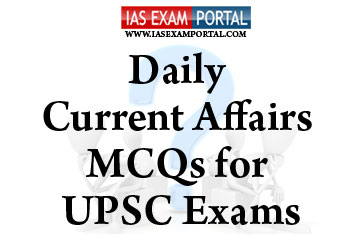
Current Affairs MCQ for UPSC Exams - 14 May 2019
Q1. Consider the following statements regarding the WTO ministerial
conference to be held in New Delhi ?
1) The two-day meeting is an effective move by developing countries to
positively influence the outcome of WTO reforms by making development at its
core and exploring all means of saving multilateralism.
2) India believes that developing countries need to work together to protect
their interests in the WTO negotiations through preservation of the core
fundamental principles of the WTO.
3) There has been no active engagement or movement on key issues of concerns for
developing countries including LDCs in the negotiating agenda till now .
Which of the above statements are true ?
a) 1 & 2only
b) 2 & 3 only
c) 1 & 3 only
d) all of the above
Q2. Which of the following are the exclusive powers enjoyed by Gram Sabha/Panchayats
at appropriate levels under the PESA (Panchayats (Extension to the Scheduled
Areas) act 1996 ?
1) Right to mandatory consultation in land acquisition, resettlement and
rehabilitation of displaced persons .
2) Panchayat at an appropriate level is entrusted with planning and management
of minor water bodies.
3) Mandatory recommendations by Gram Sabha or Panchayat for prospective
licenses/lease, concessions for mines and minerals.
4) Control over institutions and functionaries in social sector, local plans
including Tribal sub plans and resources.
a) 1,2 & 3 only
b) 2,3 & 4 only
c) 1 & 3 only
d) 2 & 4 only
Q3. Which of the following statements regarding the recently test fired
ABHYAS - High-speed Expendable Aerial Target (HEAT) are true ?
1) The configuration of ABHYAS is designed on an in-line small gas turbine
engine and uses indigenously developed MEMS based navigation system for its
navigation and guidance.
2) The HEAT system is utilized to do away with the post-launch recovery mode,
which is time-consuming and difficult in a scenario as the sea.
3) The test was conducted indigenously by ISRO from Interim Test Range,
Chandipur in Odisha.
a) 1 & 2only
b) 2 & 3 only
c) 1 & 3 only
d) all of the above
Q4. Which of the following statements describing the current status of
inflation indices in the economy are true ?
1) Wholesale inflation quickened to a six-month high of 2.92% in April,
driven in large part by accelerating food and fuel inflation.
2) CPI headline inflation came slightly below expectations, with core inflation
seeing a welcome downside surprise, which is in tandem with the growing slack in
the economy.
3) Food inflation continued to rise with sustained upward momentum in fruits and
vegetables which might continue in the summer months.
a) 1 & 2only
b) 2 & 3 only
c) 1 & 3 only
d) all the above
Q5. India has extended 1 billion dollar Line of Credit to a country to set
up its first-ever grass-root refinery at Sainshand in Dornogobi Province. The
capacity of the refinery will be 1.5 Million Metric Tons Per Annum and it will
be implemented with Exim Bank funding.
The above said province is in which of the following countries of Asia ?
a) Iran
b) Kazhakhstan
c) Mongolia
d) Maldives